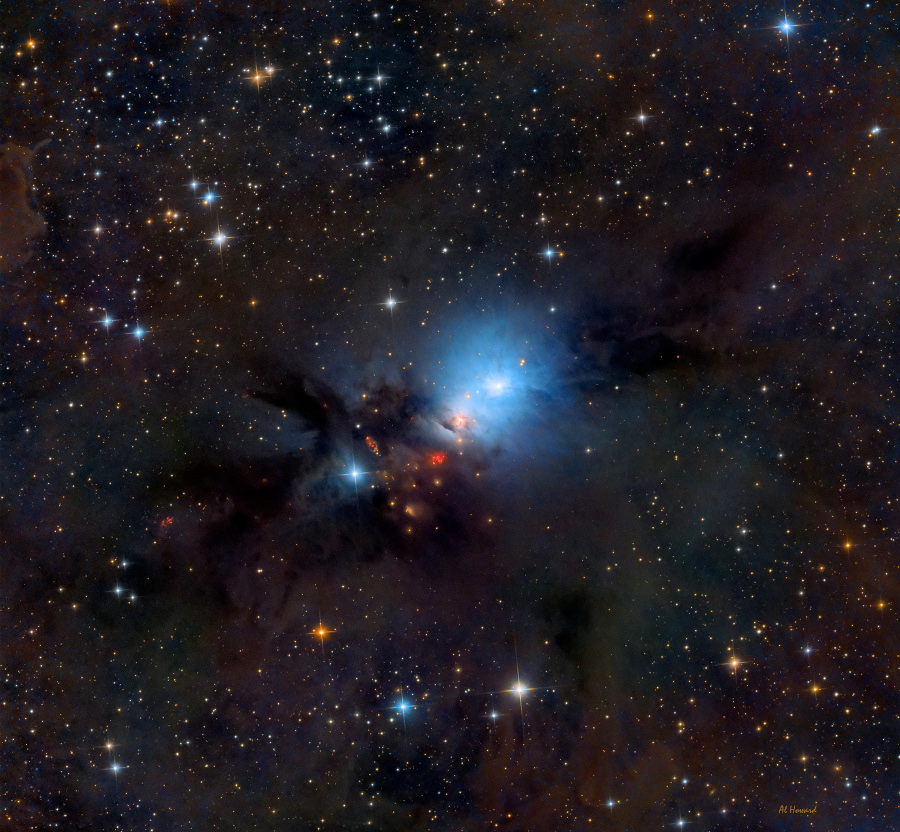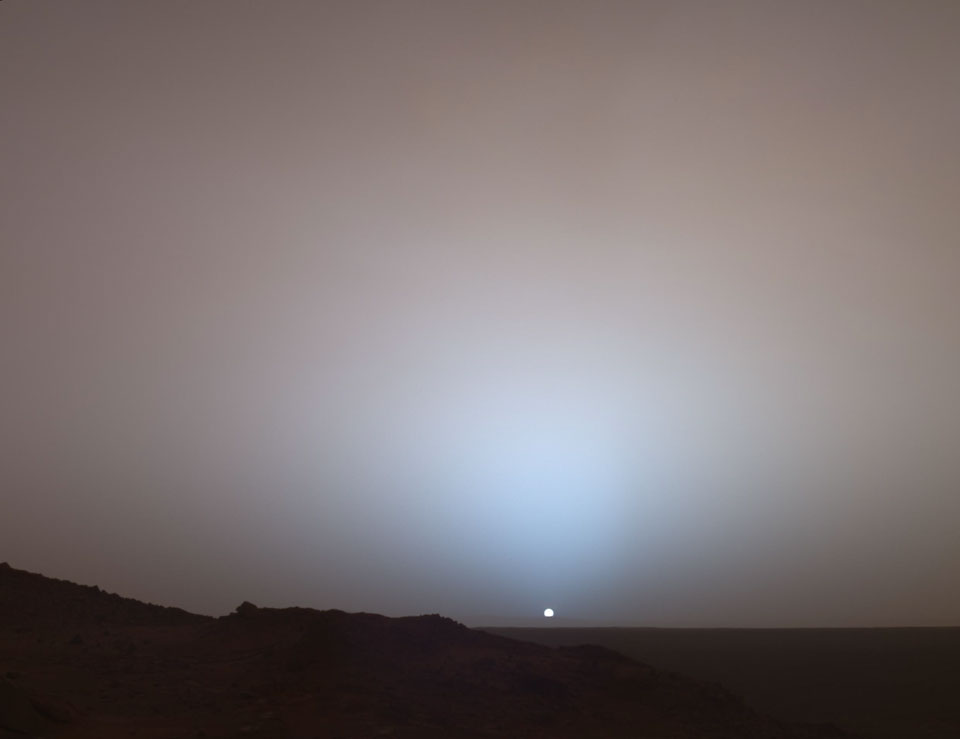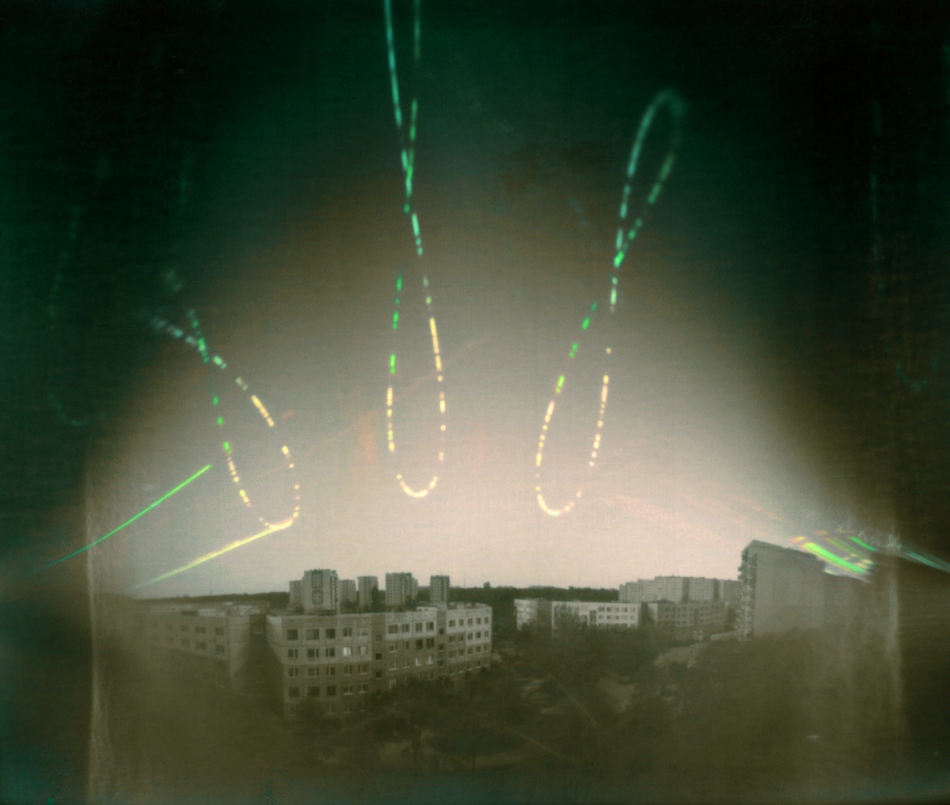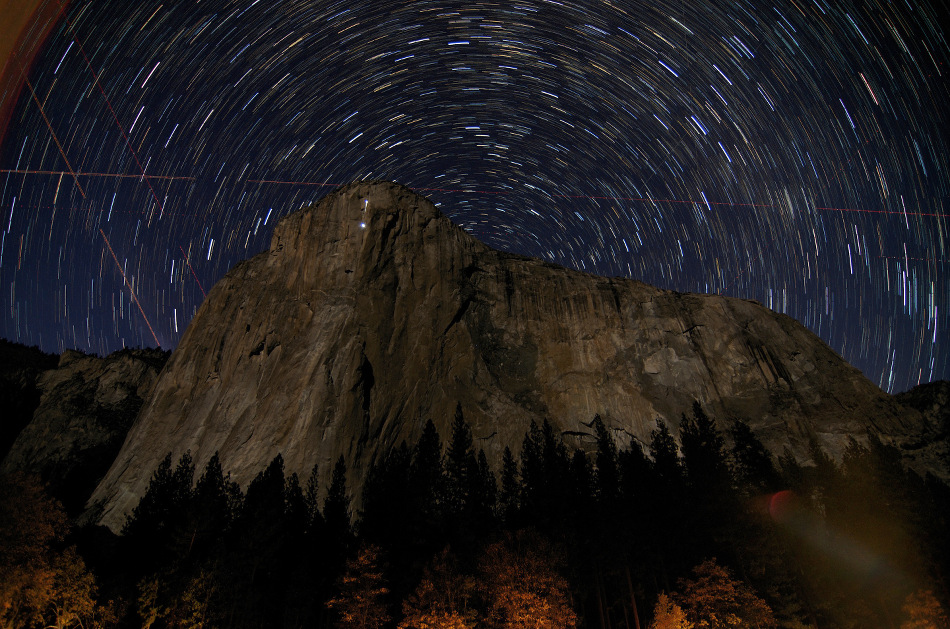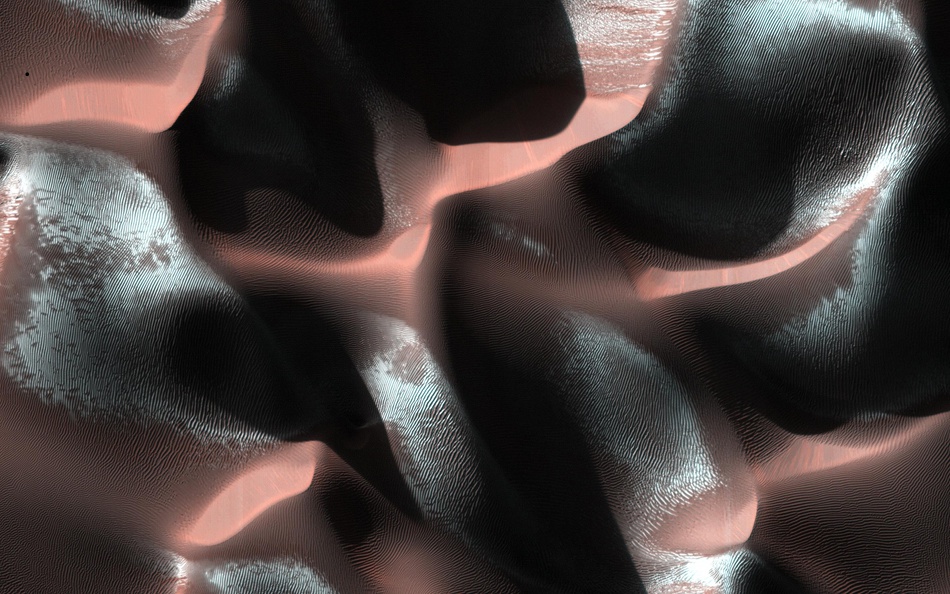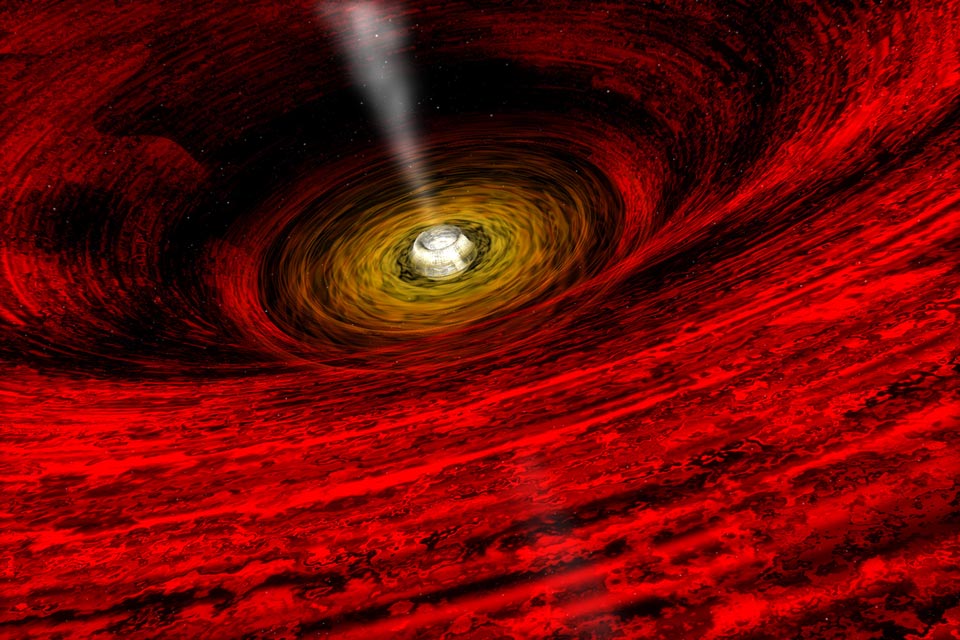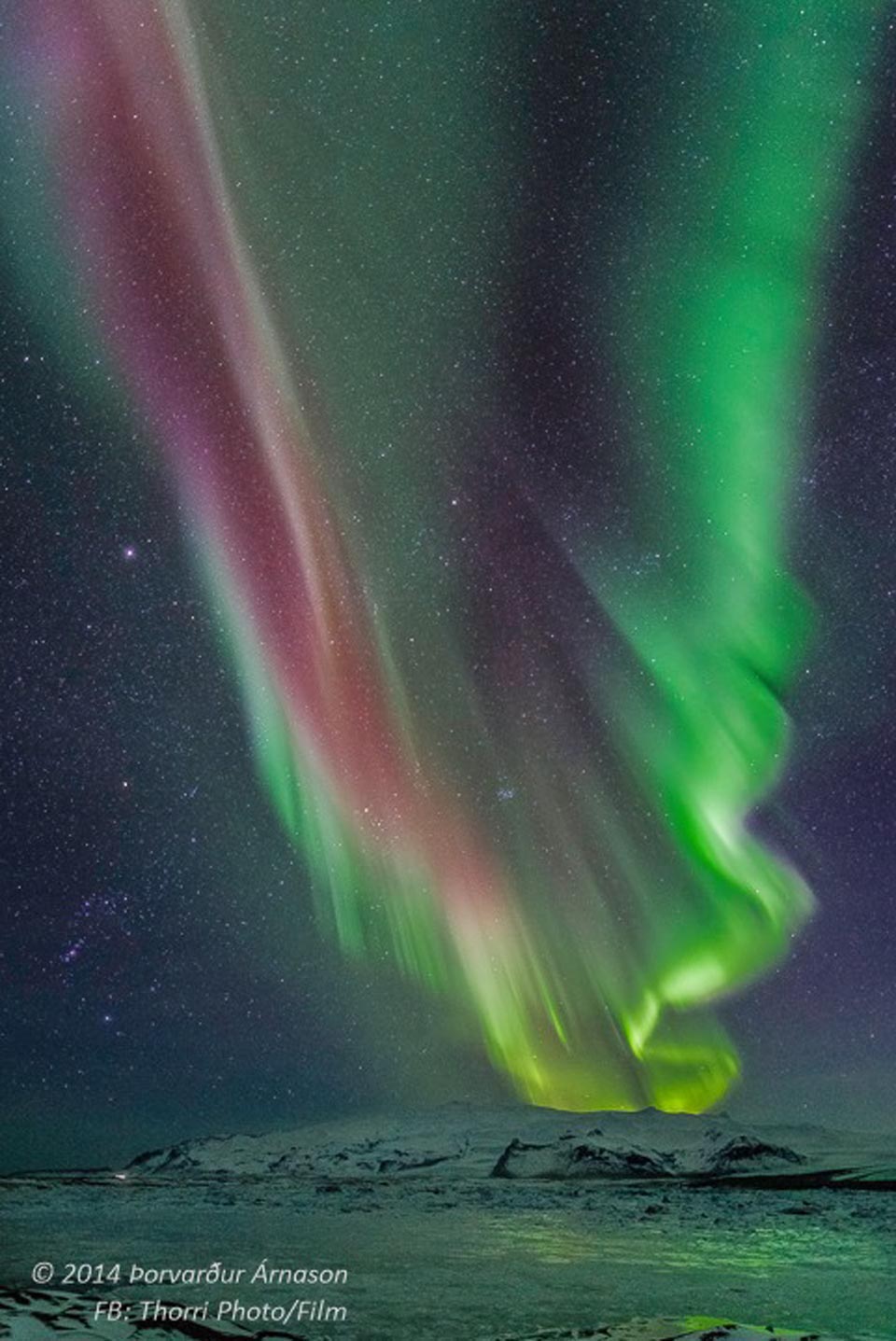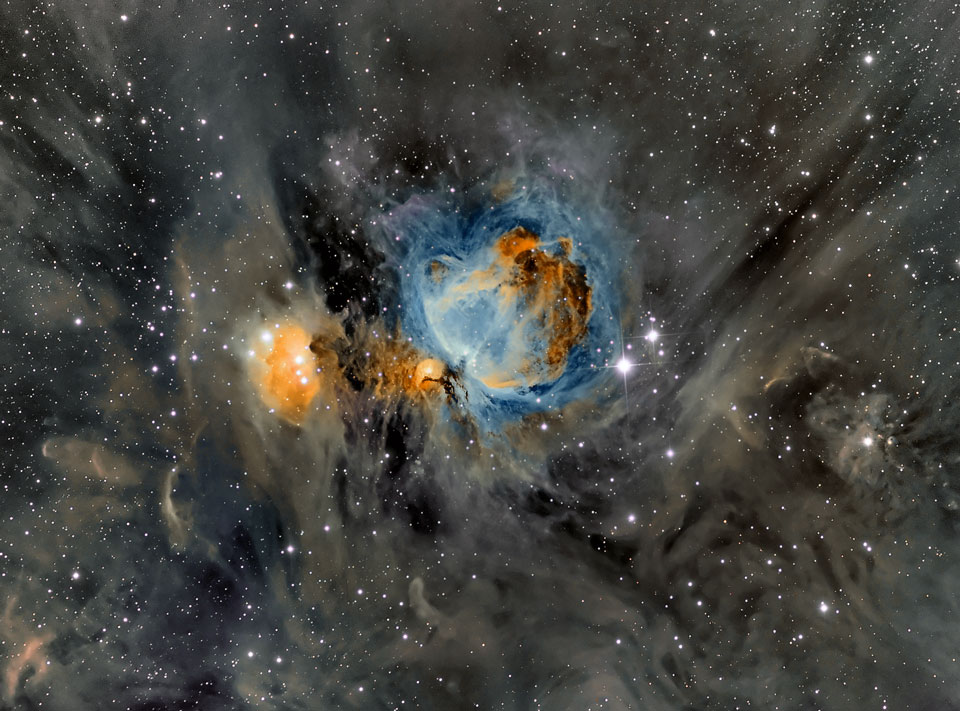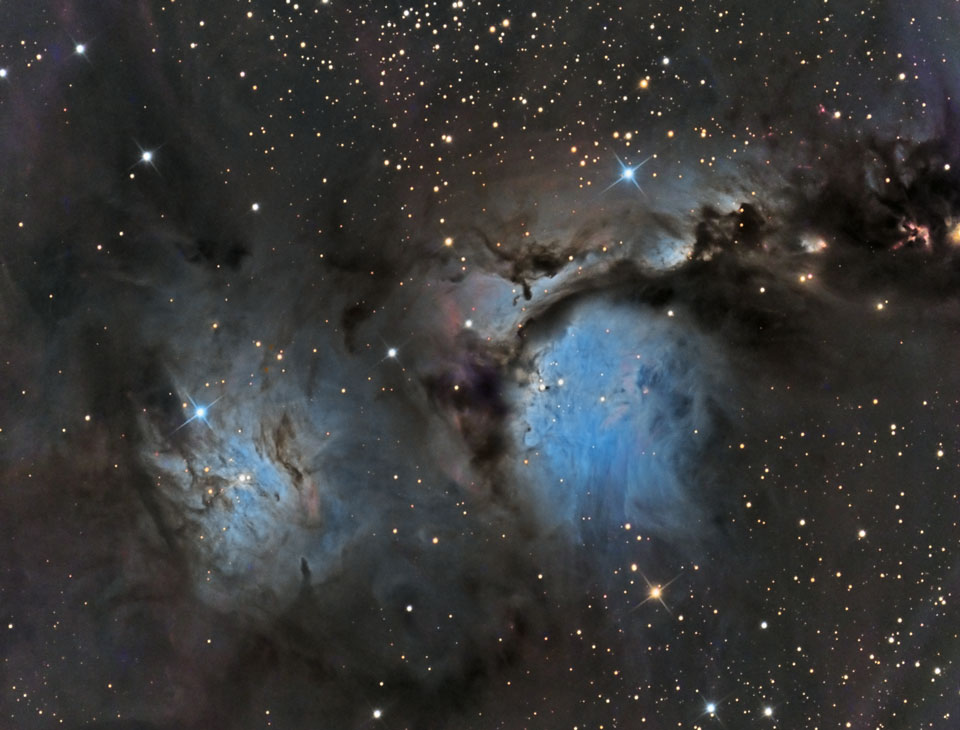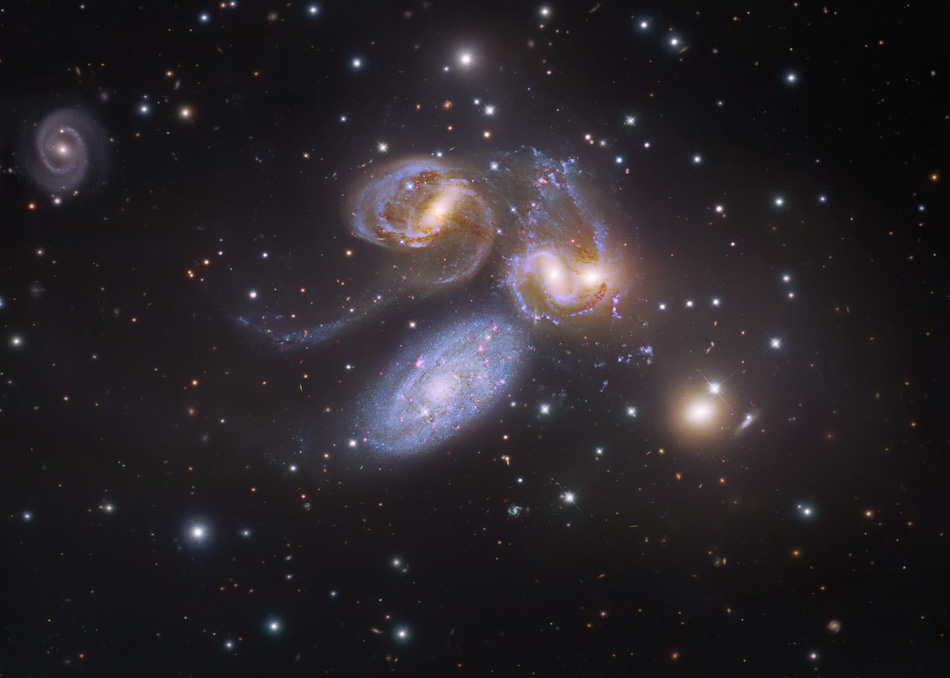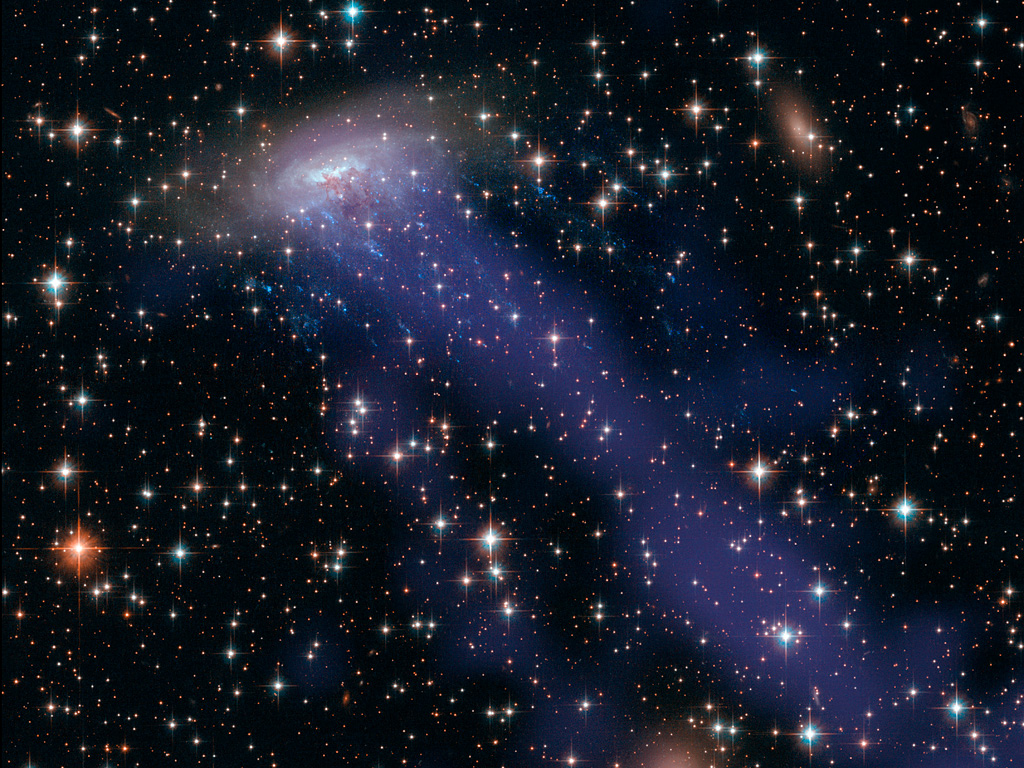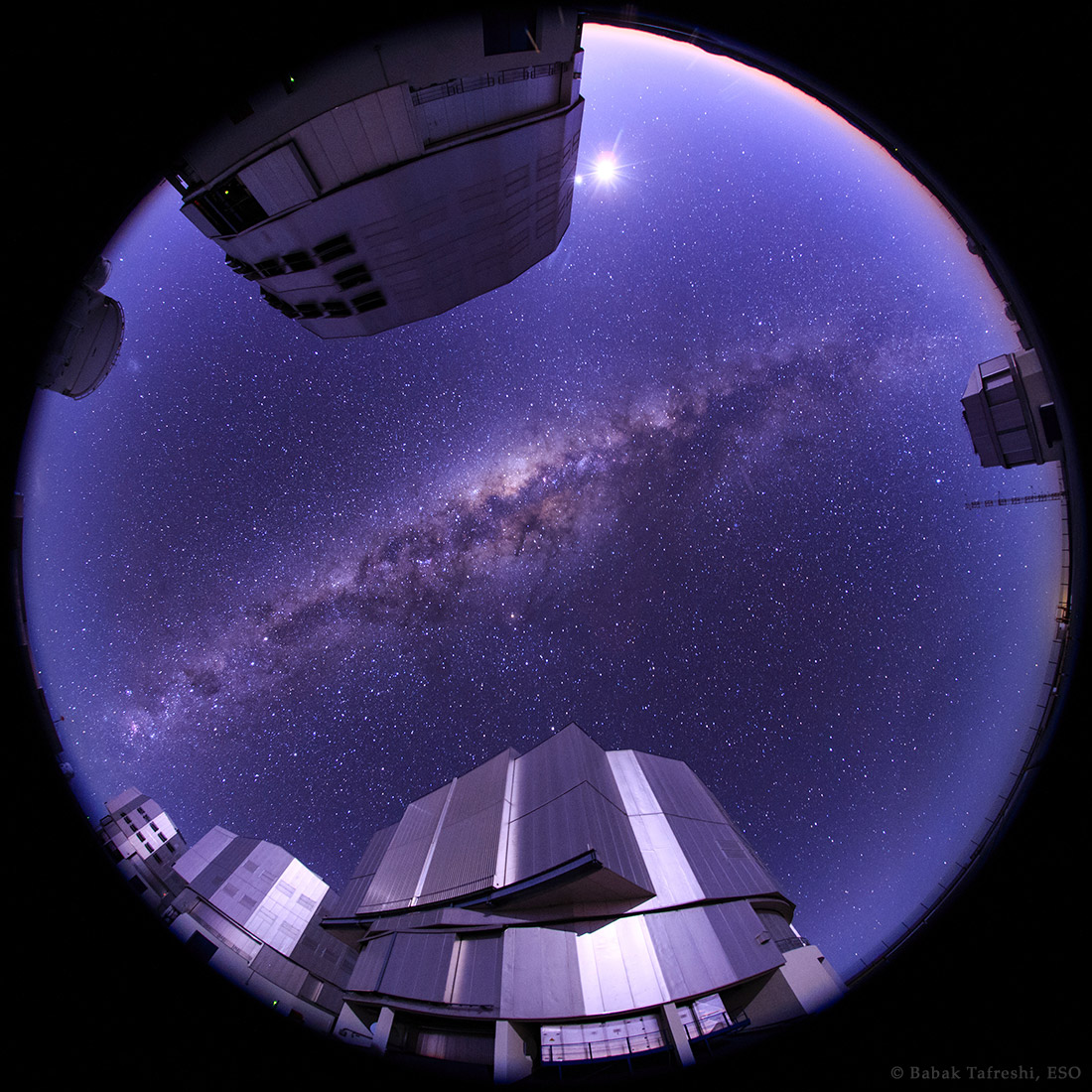
|
| Title: Astronomy Picture of the Day | |
| friendsoffortiesfive > General > General Discussion | Go to subcategory: |
| Author | Content |
|
Niceguy2
|
|
|
Date Posted:03/06/2014 11:29 PMCopy HTML I really love this site and |
|
|
tamarafromTX
|
#26 |
|
Re:Astronomy Picture of the Day Date Posted:03/19/2014 12:06 AMCopy HTML  |
|
|
Niceguy2
|
#27 |
|
Re:Astronomy Picture of the Day Date Posted:03/19/2014 10:04 PMCopy HTML Image Credit: Mars Exploration Rover Mission, Texas A&M, Cornell, JPL, NASA Explanation: What would it be like to see a sunset on Mars? To help find out, the robotic rover Spirit was deployed in 2005 to park and watch the Sun dip serenely below the distant lip of Gusev crater. Colors in the above image have been slightly exaggerated but would likely be apparent to a human explorer's eye. Fine martian dust particles suspended in the thin atmosphere lend the sky a reddish color, but the dust also scatters blue light in the forward direction, creating a bluish sky glow near the setting Sun. Because Mars is farther away, the Sun is less bright and only about two thirds the diameter it appears from Earth. Images like this help atmospheric scientists understand not only the atmosphere of Mars, but atmospheres across the Solar System, including our home Earth. |
|
|
Niceguy2
|
#28 |
|
Re:Astronomy Picture of the Day Date Posted:03/23/2014 2:28 AMCopy HTML Image Credit & Copyright: Maciej Zapiór and Łukasz Fajfrowski Explanation: Today is the equinox. The Sun crosses the celestial equator heading north at 16:57 UT, marking the northern hemisphere's first day of spring. To celebrate, consider this remarkable image following the Sun's yearly trek through planet Earth's sky, the first analemmas exposed every day through the technique of solargraphy. In fact, three analemma curves were captured using a cylindrical pinhole camera by daily making three, separate, one minute long exposures for a year, from March 1, 2013 to March 1, 2014, on a single piece of black and white photographic paper. The well-planned daily exposures began at 10:30, 12:00, and 13:30, CET from a balcony looking south from the Kozanów district in Wrocław, Poland. That year's two equinoxes on March 20 and September 22 correspond to the mid-points, not the cross-over points, along the figure-8 shaped curves. Apparent gaps in the curves are due to cloudy days. Two solid lines at the lower left were both caused by a timer switch failure that left the pinhole shutter open. |
|
|
Niceguy2
|
#29 |
|
Re:Astronomy Picture of the Day Date Posted:03/23/2014 2:31 AMCopy HTML Image Credit & Copyright: Michael Bolte (UCSC) Explanation: Towering 3,000 feet from base to summit, the famous granite face of El Capitan in Earth's Yosemite National Park just hides the planet's north celestial pole in this skyscape. Of course, the north celestial pole is at the center of all the star trails. Their short arcs reflecting the planet's daily rotation on its axis are traced in a digital stack of 36 sequential exposures. Linear trails of passing airplane navigation lights and a flare from car lights along the road below are also captured in the sequential stack. But the punctuated trail of light seen against the sheer El Capitan itself follows a climbing team on the night of November 8, 2013. The team is ascending toward the summit along The Nose, a historic rock climbing route. |
|
|
Niceguy2
|
#30 |
|
Re:Astronomy Picture of the Day Date Posted:03/23/2014 2:34 AMCopy HTML Image Credit: HiRISE, MRO, LPL (U. Arizona), NASA Explanation: Deep shadows create dramatic contrasts between light and dark in this high-resolution close-up of the martian surface. Recorded on January 24 by the HiRISE camera onboard the Mars Reconnaissance Orbiter, the scene spans about 1.5 kilometers across a sand dune field in a southern highlands crater. Captured when the Sun was just 5 degrees above the local horizon, only the dune crests are caught in full sunlight. With the long, cold winter approaching the red planet's southern hemisphere, bright ridges of seasonal frost line the martian dunes. |
|
|
Niceguy2
|
#31 |
|
Re:Astronomy Picture of the Day Date Posted:03/23/2014 4:21 PMCopy HTML Illustration Credit: April Hobart, CXC Explanation: In the center of a swirling whirlpool of hot gas is likely a beast that has never been seen directly: a black hole. Studies of the bright light emitted by the swirling gas frequently indicate not only that a black hole is present, but also likely attributes. The gas surrounding GRO J1655-40, for example, has been found to display an unusual flickering at a rate of 450 times a second. Given a previous mass estimate for the central object of seven times the mass of our Sun, the rate of the fast flickering can be explained by a black hole that is rotating very rapidly. What physical mechanisms actually cause theflickering -- and a slower quasi-periodic oscillation (QPO) -- in accretion disks surrounding black holes and neutron stars remains a topic of much research. |
|
|
tamarafromTX
|
#32 |
|
Re:Astronomy Picture of the Day Date Posted:03/23/2014 5:10 PMCopy HTML  |
|
|
Niceguy2
|
#33 |
|
Re:Astronomy Picture of the Day Date Posted:03/24/2014 9:23 PMCopy HTML Image Credit & Copyright: Þorvarður Árnason Explanation: If you see a sky like this -- photograph it. A month ago in Iceland, an adventurous photographer chanced across a sky full of aurora and did just that. In the foreground lies the stratovolcanoÖræfajökull. In the background, among other sky delights, lies the constellation of Orion, visible to the aurora's left. Auroras are sparked by energetic particles from the Sun impacting the magnetic environmentaround the Earth. Resultant energetic particles such as electrons and protons rain down near the Earth's poles and impact the air. The impacted air molecules obtain excited electrons, and when electrons inoxygen molecules fall back to their ground state, they emit green light. Auroras are known to have many shapes and colors. |
|
|
USMmom
|
#34 |
|
Re:Astronomy Picture of the Day Date Posted:03/24/2014 11:24 PMCopy HTML 
|
|
|
Niceguy2
|
#35 |
|
Re:Astronomy Picture of the Day Date Posted:03/25/2014 9:26 PMCopy HTML Image Credit & Copyright: Robert Fields Explanation: What surrounds a hotbed of star formation? In the case of the Orion Nebula -- dust. The entire Orion field, located about 1600 light years away, is inundated with intricate and picturesquefilaments of dust. Opaque to visible light, dust is created in the outer atmosphere of massive cool stars and expelled by a strong outer wind of particles. The Trapezium and other forming star clusters are embedded in the nebula. The intricate filaments of dust surrounding M42 and M43 appear gray in the above image, while central glowing gas is highlighted in brown and blue. Over the next few million years much of Orion's dust will be slowly destroyed by the very stars now being formed, or dispersed into the Galaxy. |
|
|
tamarafromTX
|
#36 |
|
Re:Astronomy Picture of the Day Date Posted:03/25/2014 10:25 PMCopy HTML |
|
|
Niceguy2
|
#37 |
|
Re:Astronomy Picture of the Day Date Posted:03/25/2014 11:16 PMCopy HTML Ya NUT! LOL
|
|
|
tamarafromTX
|
#38 |
|
Re:Astronomy Picture of the Day Date Posted:03/26/2014 12:00 AMCopy HTML
|
|
|
tamarafromTX
|
#39 |
|
Re:Astronomy Picture of the Day Date Posted:03/26/2014 12:02 AMCopy HTML
I am laughing like a nut!!!!!!!!!!!!!!!!!!!!!!!!!!!!!!!!! Coughing because I've laughed so much. LOL @ the "bravo" !!!
|
|
|
Niceguy2
|
#40 |
|
Re:Astronomy Picture of the Day Date Posted:03/26/2014 4:17 AMCopy HTML  |
|
|
USMmom
|
#41 |
|
Re:Astronomy Picture of the Day Date Posted:03/26/2014 1:15 PMCopy HTML Joe, Luke wants his room in the solar system now...Kimberly ordered him comforter set should be here today...she got him a star light that u can project things on the ceiling...she got him the things that stick on the ceiling (will not hurt the ceiling) of the solar system and shows how to place them....She is waiting until her husband gets home for help...she bought him a big picture already framed that glows in the dark...but she wants a pic of the planets...I google it and sent her the link but, she said she already saw those...She wants it poster size...do you know any sites we might could find any? Thanks I love these pics...
|
|
|
Niceguy2
|
#42 |
|
Re:Astronomy Picture of the Day Date Posted:03/26/2014 9:51 PMCopy HTML That's cool, Kay. I'm glad Luke is interested in astronomy. I sure was when I was a kid, and still am. Sorry I don't know of any sites like you want.
|
|
|
Niceguy2
|
#43 |
|
Re:Astronomy Picture of the Day Date Posted:03/26/2014 9:54 PMCopy HTML Image Credit & Copyright: Ian Sharp Explanation: An eerie blue glow and ominous columns of dark dust highlight M78 and other bright reflection nebula in the constellation of Orion. The dark filamentary dust not only absorbs light, but also reflects the light of several bright blue stars that formed recently in the nebula. Of the two reflection nebulas pictured above, the more famous nebula is M78, in the image center, while NGC 2071 can be seen to its lower left. The same type of scattering that colors the daytime sky further enhances the blue color. M78 is about five light-years across and visible through a small telescope. M78 appears above only as it was 1600 years ago, however, because that is how long it takes light to go from there to here. M78 belongs to the larger Orion Molecular Cloud Complex that contains the Great Nebula in Orion and theHorsehead Nebula. |
|
|
tamarafromTX
|
#44 |
|
Re:Astronomy Picture of the Day Date Posted:03/26/2014 10:01 PMCopy HTML
|
|
|
Niceguy2
|
#45 |
|
Re:Astronomy Picture of the Day Date Posted:03/27/2014 11:27 PMCopy HTML Image Assembly & Processing: Robert Gendler and Judy Schmidt Image Data: Subaru Telescope (NAOJ), Hubble Legacy Archive, R. Gendler Explanation: The first identified compact galaxy group, Stephan's Quintet is featured in this remarkable image constructed with data drawn from Hubble Legacy Archive and the Subaru Telescope on the summit of Mauna Kea. The galaxies of the quintet are gathered near the center of the field, but really only four of the five are locked in a cosmic dance of repeated close encounters taking place some 300 million light-years away. The odd man out is easy to spot, though. The interacting galaxies, NGC 7319, 7318A, 7318B, and 7317 have a more dominant yellowish cast. They also tend to have distorted loops and tails, grown under the influence of disruptive gravitational tides. The mostly bluish galaxy, NGC 7320, is in the foreground about 40 million light-years distant, and isn't part of the interacting group. Still, captured in this field above and to the left of Stephan's Quintet is another galaxy, NGC 7320C, that is also 300 million light-years distant. Of course, including it would bring the four interacting galaxies back up to quintet status. Stephan's Quintet lies within the boundaries of the high flying constellation Pegasus. At the estimated distance of the quintet's interacting galaxies, this field of view spans over 500,000 light-years. |
|
|
tamarafromTX
|
#46 |
|
Re:Astronomy Picture of the Day Date Posted:03/28/2014 12:06 AMCopy HTML  |
|
|
Niceguy2
|
#47 |
|
Re:Astronomy Picture of the Day Date Posted:03/28/2014 6:14 PMCopy HTML Image Credit: NASA, ESA, CXC Explanation: Spiral galaxy ESO 137-001 hurtles through massive galaxy cluster Abell 3627 some 220 million light years away. The distant galaxy is seen in this colorful Hubble/Chandra composite image through a foreground of the Milky Way's stars toward the southern constellation Triangulum Australe. As the spiral speeds along at nearly 7 million kilometers per hour, its gas and dust is stripped away whenram pressure with the cluster's own hot, tenuous intracluster medium overcomes the galaxy's gravity. Evident in Hubble's near visible light data, bright star clusters have formed in the stripped material along the short, trailing blue streaks. Chandra's X-ray data shows off the enormous extent of the heated, stripped gas as diffuse, darker blue trails stretching over 400,000 light-years toward the bottom right. The significant loss of dust and gas will make new star formation difficult for this galaxy. A yellowish elliptical galaxy, lacking in star forming dust and gas, is just to the right of ESO 137-001 in the frame. |
|
|
tamarafromTX
|
#48 |
|
Re:Astronomy Picture of the Day Date Posted:03/28/2014 8:15 PMCopy HTML  |
|
|
Niceguy2
|
#49 |
|
Re:Astronomy Picture of the Day Date Posted:03/29/2014 8:29 PMCopy HTML Image Credit & Copyright: Babak Tafreshi (TWAN), ESO Ultra HD Expedition Explanation: As dawn broke on March 27, the center of the Milky Way Galaxy stood almost directly above the European Southern Observatory's Paranal Observatory. In the dry, clear sky of Chile's Atacama desert, our galaxy's dusty central bulge is flanked by Paranal's four 8 meter Very Large Telescope units in this astronomical fisheye view. Along the top, Venus is close to the eastern horizon. The brilliant morning star shines very near a waning crescent Moon just at the edge of one of the telescope structures. Despite the bright pairing in the east, the Milky Way dominates the scene though. Cut by dust lanes and charged with clouds of stars and glowing nebulae, the center of our galaxy sprawls across the darker zenith even as the deep blue sky grows brighter and buildings still glint in moonlight. |
|
|
tamarafromTX
|
#50 |
|
Re:Astronomy Picture of the Day Date Posted:03/30/2014 4:55 AMCopy HTML Thanks for sharing all of the fascinating posts.
|







